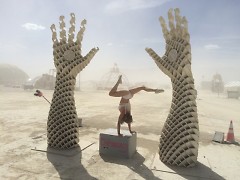Burning Man is an experiment in urban design that is impractical, unsustainable and a little insane- all of of which are precisely what make it so valuable. The 30 year old annual festival is one part rave, one part temporary hippie commune, one part massive sculpture exhibition and one part post-apocalypitic libertarian fantasyland. For a week on an alkali salt flat in Western Nevada, Black Rock City rises from nothing to become to become a temporary home for 70,000 people, and site of Burning Man.
Black Rock City is a semi-circular grid with a vast expanse of open playa in the center. The street plan radiates out from the eponymous Man, a large wooden sculpture that is erected and burned each year. The open playa is littered with dozens of massive sculptures, pavilions, and extreme art cars (many decked out, party-carrying, fire-breathing busses). The city streets are dusty and full of bikes, lined with tents, temporary yurts and RVs. Many attendees band together into camps of a dozen to a few hundred. Camps have themes and offer their own programming, including (many!) bars, dance clubs, massage parlors, meditation spaces and much, much freakier things.
There are scheduled times that certain large installations burn and some camps have a schedule of programming, but for the most part there’s not a sequence of events. The city and the event exist to be lived in and explored. It’s a far cry from a music festival, which is structured around the line-up of acts.
All cities are illustrations of ideology, whether they try to be or not. In the case of Black Rock City, this is unusually clear. There are 10 principles that animate the event, and every year for one week those principles are incarnated as a city. The principles are radical inclusion, gifting, de-commodification, radical self-reliance, radical self-expression, communal effort, civic responsibility, leaving no trace, participation, and immediacy. These principles play out in a variety of ways (and sometimes don’t). Nothing is for sale; everyone brings everything they need to survive. There’s no bartering, only gifting. There are no trash cans; everything packed in is packed out. There’s no branding: nothing is visibly sponsored by anything. Radical self-expression often takes the form of out-there clothing, or no clothing at all.
Cities are physical, cultural and political frameworks that allow us to be a certain version of ourselves. A common greeting in Black Rock City is “welcome home.” There’s a sense that for many attendees, Burning Man is a place where dormant elements of one’s character can finally flourish.
What occurred to me at Burning Man is that every city has this effect- it’s just not usually so noticeable. Every city creates a stage where we’re encouraged to perform a certain version of ourselves, and discouraged from performing other versions. You can sense this as you travel. The person you’re allowed to be in Paris is different from the person you’re allowed to be Pyongyang.
Cities are crystalized ideologies. They’re the stuff we continue to live with long after beliefs become architecture.
Unlike permanent cities, in Black Rock City there’s no time for the physical and ideological structures to drift apart. There’s no leftover infrastructure from failed urban experiments of yesteryear, because there’s no leftover infrastructure at all. If there’s a rancid fruit waiting to replace Burning Man’s utopian flower, it’s never given time to rot. Before the fantasyland can begin crumble, it’s wiped away by design. This is brilliant precisely because it’s not sustainable for more than a week. If cities are massive works of semi-permanent design; Burning Man is a massive ephemeral artwork. The distinction between design and art is that the former serves a practical function, while the latter only finds its value by being impractical, operating in the realm of fantasy.
Burning Man is a livable, impractical model for an alternative urbanism. For anyone thinking about how ideas become urban spaces, and how urban spaces let us become who we are, it’s well worth the dust.
The Rapidian, a program of the 501(c)3 nonprofit Community Media Center, relies on the community’s support to help cover the cost of training reporters and publishing content.
We need your help.
If each of our readers and content creators who values this community platform help support its creation and maintenance, The Rapidian can continue to educate and facilitate a conversation around issues for years to come.
Please support The Rapidian and make a contribution today.

